Low dose Naltrexone for induction of remission in inflammatory bowel disease patients
- PMID: 29523156
- PMCID: PMC5845217
- DOI: 10.1186/s12967-018-1427-5
Low dose Naltrexone for induction of remission in inflammatory bowel disease patients
Abstract
Background: Around 30% of patients with inflammatory bowel disease (IBD) are refractory to current IBD drugs or relapse over time. Novel treatments are called for, and low dose Naltrexone (LDN) may provide a safe, easily accessible alternative treatment option for these patients. We investigated the potential of LDN to induce clinical response in therapy refractory IBD patients, and investigated its direct effects on epithelial barrier function.
Methods: Patients not in remission and not responding to conventional therapy were offered to initiate LDN as a concomitant treatment. In total 47 IBD patients prescribed LDN were followed prospectively for 12 weeks. Where available, endoscopic remission data, serum and biopsies were collected. Further the effect of Naltrexone on wound healing (scratch assay), cytokine production and endoplasmic reticulum (ER) stress (GRP78 and CHOP western blot analysis, immunohistochemistry) were investigated in HCT116 and CACO2 intestinal epithelial cells, human IBD intestinal organoids and patient samples.
Results: Low dose Naltrexone induced clinical improvement in 74.5%, and remission in 25.5% of patients. Naltrexone improved wound healing and reduced ER stress induced by Tunicamycin, lipopolysaccharide or bacteria in epithelial barriers. Inflamed mucosa from IBD patients showed high ER stress levels, which was reduced in patients treated with LDN. Cytokine levels in neither epithelial cells nor serum from IBD patients were affected.
Conclusions: Naltrexone directly improves epithelial barrier function by improving wound healing and reducing mucosal ER stress levels. Low dose Naltrexone treatment is effective and safe, and could be considered for the treatment of therapy refractory IBD patients.
Keywords: Crohn’s disease; Endoplasmic reticulum stress; Naltrexone; Ulcerative colitis; Wound healing.
Figures
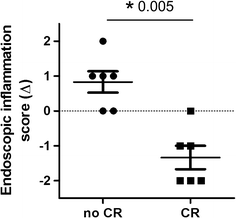
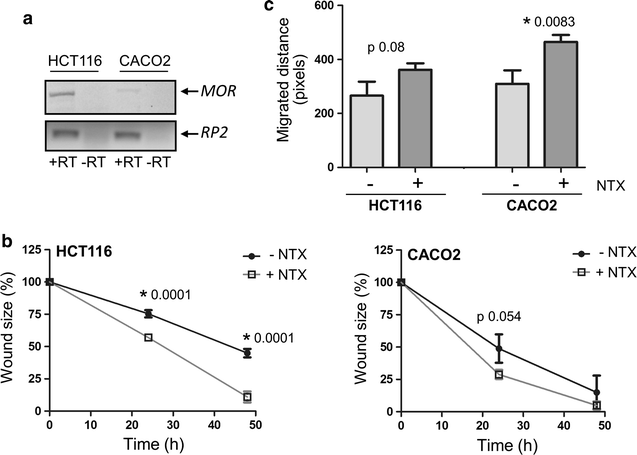
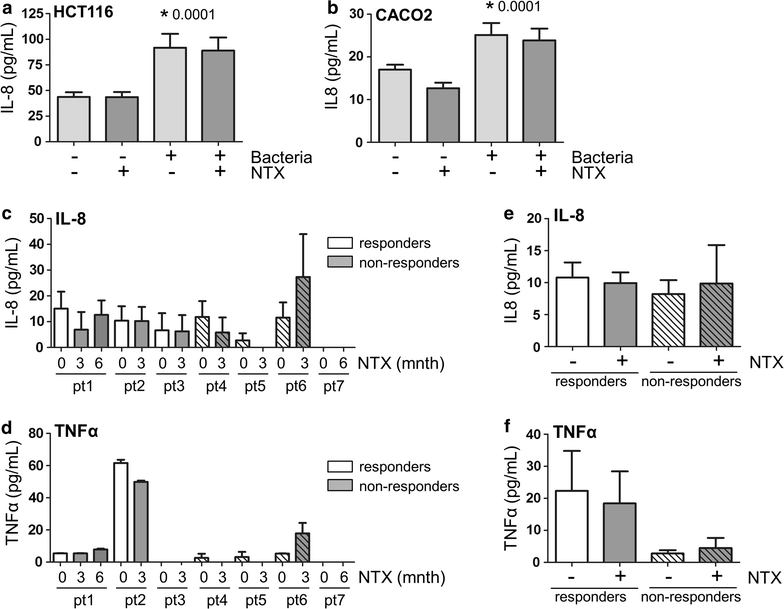
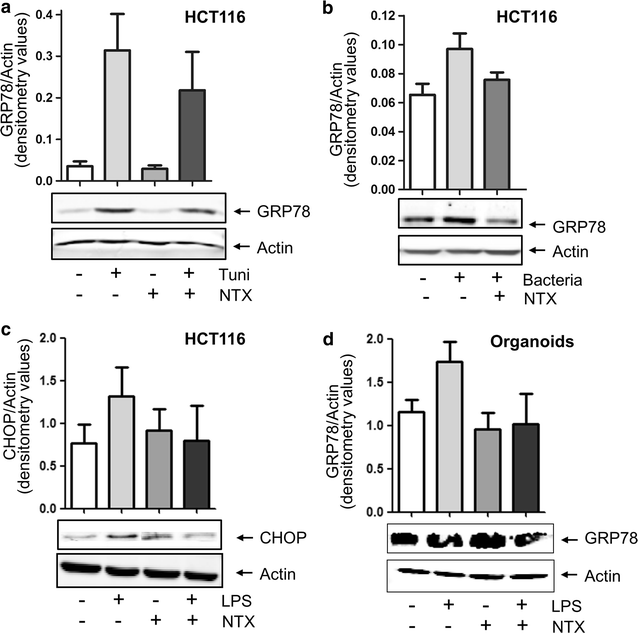
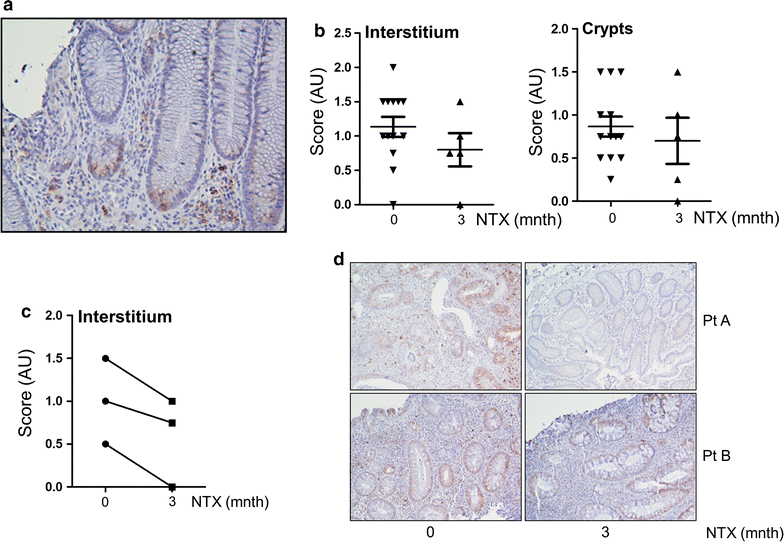
Similar articles
-
A Direct Effect of Sex Hormones on Epithelial Barrier Function in Inflammatory Bowel Disease Models.Cells. 2019 Mar 19;8(3):261. doi: 10.3390/cells8030261. Cells. 2019. PMID: 30893871 Free PMC article.
-
Bitter melon protects against ER stress in LS174T colonic epithelial cells.BMC Complement Altern Med. 2017 Jan 3;17(1):2. doi: 10.1186/s12906-016-1522-1. BMC Complement Altern Med. 2017. PMID: 28049460 Free PMC article.
-
Pregnane X receptor agonists enhance intestinal epithelial wound healing and repair of the intestinal barrier following the induction of experimental colitis.Eur J Pharm Sci. 2014 May 13;55:12-9. doi: 10.1016/j.ejps.2014.01.007. Epub 2014 Jan 29. Eur J Pharm Sci. 2014. PMID: 24486481
-
Intestinal enteroids/organoids: A novel platform for drug discovery in inflammatory bowel diseases.World J Gastroenterol. 2019 Aug 14;25(30):4125-4147. doi: 10.3748/wjg.v25.i30.4125. World J Gastroenterol. 2019. PMID: 31435168 Free PMC article. Review.
-
Role of epithelial cells in the pathogenesis and treatment of inflammatory bowel disease.J Gastroenterol. 2016 Jan;51(1):11-21. doi: 10.1007/s00535-015-1098-4. Epub 2015 Jul 3. J Gastroenterol. 2016. PMID: 26138071 Review.
Cited by
-
Endoplasmic Reticulum Stress, a Target for Drug Design and Drug Resistance in Parasitosis.Front Microbiol. 2021 May 31;12:670874. doi: 10.3389/fmicb.2021.670874. eCollection 2021. Front Microbiol. 2021. PMID: 34135878 Free PMC article. Review.
-
Low-dose naltrexone for the induction of remission in patients with mild to moderate Crohn's disease: protocol for the randomised, double-blinded, placebo-controlled, multicentre LDN Crohn study.BMJ Open. 2022 Apr 8;12(4):e058358. doi: 10.1136/bmjopen-2021-058358. BMJ Open. 2022. PMID: 35396307 Free PMC article.
-
Psychopharmacological Therapy Positively Modulates Disease Activity in Inflammatory Bowel Disease: A Systematic Review.Int J Mol Sci. 2025 Jul 6;26(13):6514. doi: 10.3390/ijms26136514. Int J Mol Sci. 2025. PMID: 40650291 Free PMC article.
-
Low Dose Naltrexone and Lung Cancer: A Case Report and Discussion.Cureus. 2018 Jul 5;10(7):e2924. doi: 10.7759/cureus.2924. Cureus. 2018. PMID: 30197847 Free PMC article.
-
Extended-release Naltrexone Improves Viral Suppression Among Incarcerated Persons Living with HIV and Alcohol use Disorders Transitioning to the Community: Results From a Double-Blind, Placebo-Controlled Trial.J Acquir Immune Defic Syndr. 2018 Sep 1;79(1):92-100. doi: 10.1097/QAI.0000000000001759. J Acquir Immune Defic Syndr. 2018. PMID: 29781884 Free PMC article. Clinical Trial.
References
-
- Khan NH, Almukhtar RM, Cole EB, Abbas AM. Early corticosteroids requirement after the diagnosis of ulcerative colitis diagnosis can predict a more severe long-term course of the disease—a nationwide study of 1035 patients. Aliment Pharmacol Ther. 2014;40:374–381. doi: 10.1111/apt.12834. - DOI - PubMed
Publication types
MeSH terms
Substances
LinkOut - more resources
Full Text Sources
Other Literature Sources
Research Materials
Miscellaneous

